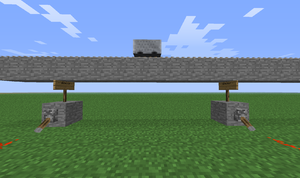//Detector
(Created page with "« 返回") |
(Created page with "检测器与转辙器非常相似,两者的区别在于: * 检测器不切换轨道。 * 检测器可检测多条轨道。") |
||
| Line 5: | Line 5: | ||
== 介绍 == | == 介绍 == | ||
检测器与转辙器非常相似,两者的区别在于: | |||
* 检测器不切换轨道。 | |||
* | * 检测器可检测多条轨道。 | ||
* | |||
<div lang="en" dir="ltr" class="mw-content-ltr"> | <div lang="en" dir="ltr" class="mw-content-ltr"> | ||
Revision as of 14:27, 5 September 2024
介绍
检测器与转辙器非常相似,两者的区别在于:
- 检测器不切换轨道。
- 检测器可检测多条轨道。
You can use detector signs to detect certain trains on a very long piece of track. You can use it, for example, to stop spawning trains if the track is currently in use. You can also use it to make trains take alternative routes if a certain track is in use.
Syntax
First line: Whether to detect trains or single carts
Second line: detector (name)
Third line: Statement 1
Fourth line: Statement 2
If the third and fourth lines are kept empty, it will toggle the lever whenever it finds a train. A name can optionally be put after the word detector, to make sure two detector signs can only find each other.
Placement
Placement is rather difficult, since you need to use pairs of detector signs, one on both ends of the track to detect. The detector signs have to face each other, or they will have a hard time finding each other. Both signs are operated simultaneously, so you can use both ends to toggle a lever, using 4 statements in total. By adding multiple detector signs underneath one track you can expand the amount of statements.
Statements
On the third and fourth lines you can put the statements to evaluate.

